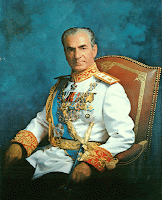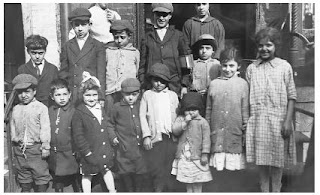The Days of Iran's Last Shah, Mohammed Reza Pahlavi
 "Shah is a kind of magic word with the Persian people. " Mohammed Reza Pahlavi, Shah of Iran 1941-1979
"Shah is a kind of magic word with the Persian people. " Mohammed Reza Pahlavi, Shah of Iran 1941-1979The Iranian past, similar to the Russian past, has been hidden for decades. Little did Stalin know in the 1930s that forcing a policy of kolkhozy or collectivization of peasants' lands, would create a radical resistance movement among the kulaks and peasants against collectivization. The Shah of Iran was not Stalin, in fact, comparably far from him. But his White Revolution as he phrased it, beginning in 1963 and ending in 1977, mobilized semi-industrial peasants known as the bazaaris in an alliance with the religious clerics against rapid modernization and the Shah. These modernization policies introduced a series of land reforms and Westernizing trends that would elevate Iran onto an industrialist and capitalist platform alongside the major Western powers of the day. The problem with the Shah's policies were not that he sought to ring in capitalism to the Iranian countryside, but that he aimed to do so without loosening his autocratic grip on government and economic controls. The Shahanshah began as far back as the 6th century Achaemenid Empire before Christ.The Shah was the 'king of kings', also referred to as the 'Aryamehr' or light of the Aryans, and the Pahlavis as well as their predecessors were in no way about to let that title go to the wind.
The Shah's advisors were often put to the arduous task of fulfilling the modernization policies promised by the Shah. Interestingly, none of them lasted in their position long enough to reap the rewards of their accomplishments. The Shah often deposed of them before they became too powerful, threatening his title. Agricultural minister Hasan Arsanjani, in 1962, began the first phase of the reform, selling land titles from large landlords to peasant sharecroppers. The transference of sharecroppers to landowners was staggering and the result benefited Arsanjani immensely. It is no surprise that the result of his success threatened the Shah and Arsanjani was forced to resign in 1963.

The Shah turned to the West for modernization, often times at the expense of what was best for his own country. Peasants whom became landowners began to over-invest in agricultural equipment, causing an import over export imbalance in Iran. As more cities modernized adorned with private factories, these factories needed the necessary tools and resources to keep up with modern technical advances. The result was that often times these tools and resources were managed and owned by foreign investors. Iranian historian and professor at the California University at Berkley states in her book, Modern Iran: Roots of Revolution, "Sophisticated foreign equipment demanded foreign technicians and workers, who in the 1970s streamed in by the tens of thousands. Americans and Europeans were concentrated in the high technical posts...the skilled foreigners, to the contrary, got higher salaries than Iranians--sometimes several times higher--and this, plus their behavior and their pushing up the price of scarce housing, helped to make them objects of resentment" (Modern Iran, 160). The oil industry in Iran was perhaps the leading precursor to the Revolution of 1979. In the early 1970s, the Shah has invested most of the oil money, not on boostering local traditional industries as textiles upheld by the bazaaris, or what Keddie termed as the 'petty bourgeosie' class of Iran, but rather on military fighter planes and defense buildup. Keddie states, "American military suppliers like Grumman, Lockheed, and Westinghouse took over key positions in the economy. Many potentially productive Iranians, including a high percentage of the technically trained, were increasingly concentrated in the armed forces and in building projects for army and naval bases and for facilities to transport and house military equipment" (Modern Iran, 164).
In addition to the Shah's monopolization of the oil revenue, grew deep discontent by the bazaari class and the ulama. As more of the ulama and religious clerics grew disenfranchised (they used to hold most of the land in the countryside as large landowners) with land reform, they began to foment the jargon of anti-Shah rhetoric that would spread across Iran like a forest fire. The bazaaris, feeling neglected by their Shah to massive industry and foreign enterprise, began to ally with the religious clerics demanding the end of Shahanshah rule. They both feared that with rising modernization, they would lose their religion, traditions, and Iranian way of life to the West.
1979 marks the year that the Ayatollah Khomeini took what Iran had once had--healthy diversity, complicated political pluralism, and a moderate religiosity, and threw a black veil over it. Now everyone in Iran was to conform to Khomeini's views on Islam and his treatise on 'religious governance'. He placed himself at the head of the government, calling himself the 'Supreme Leader' under Allah. The once voted for semi-secular Constitution of 1906 was completely changed to a predominantly religious constitution under the ayatollah and his Islamic Republic Party. Today, Iran is still trying to make sense of the past it once carried and the present it now shoulders. Did Iranians ask for what they received in 1979? Absolutely not. Most of the revolutionaries were Islamic moderates hoping for a renewed interest in the 1906 Constitution. Khomeini himself, prior to the revolution, promised to uphold these semi-secular tenets ingrained in the Majles' Constitution. He certainly did not uphold his end of the bargain.
 The Shah no longer rules over Iran, but the legacy of Mohammad Reza Pahlavi still surfaces in the Iranian consciousness. Most Iranians despised the rule of the Shah, and resented his inability to uphold the Iranian Constitution. He tried to change his ways too far in the game, perhaps, seeking to bring democracy to Iran under his dictatorial rule. This was not good enough for the Iranians, but the Ayatollah's actions after 1979 were not either. Many Iranians now long for the days of the Shah, much the same way as Russians long for their former Tsar Nicolas. Others prefer the religious conservatism of the mujtahids. But most prefer to see a true democracy with elected representation. Maybe Iran can one day become a democracy like America, we will just have to have faith in the Iranian people in the meantime, and support them to the utmost.
The Shah no longer rules over Iran, but the legacy of Mohammad Reza Pahlavi still surfaces in the Iranian consciousness. Most Iranians despised the rule of the Shah, and resented his inability to uphold the Iranian Constitution. He tried to change his ways too far in the game, perhaps, seeking to bring democracy to Iran under his dictatorial rule. This was not good enough for the Iranians, but the Ayatollah's actions after 1979 were not either. Many Iranians now long for the days of the Shah, much the same way as Russians long for their former Tsar Nicolas. Others prefer the religious conservatism of the mujtahids. But most prefer to see a true democracy with elected representation. Maybe Iran can one day become a democracy like America, we will just have to have faith in the Iranian people in the meantime, and support them to the utmost.Sources:
Keddie, Nikki R. Modern Iran: Roots and Results of Revolution; Yale University Press, New
Haven, 2006.



Comments